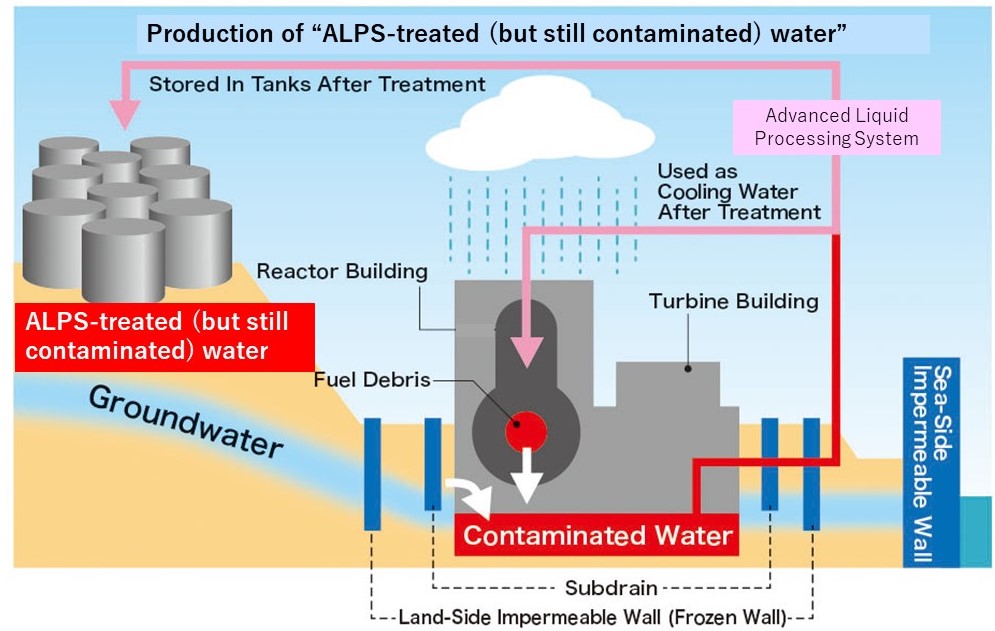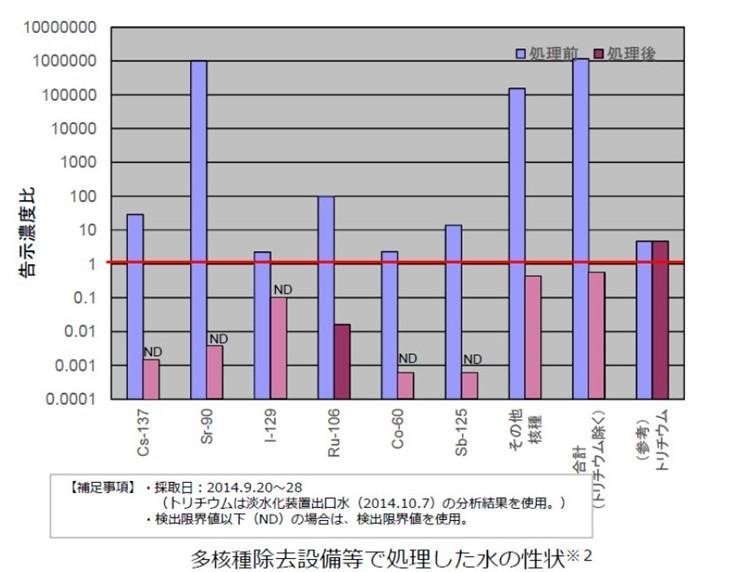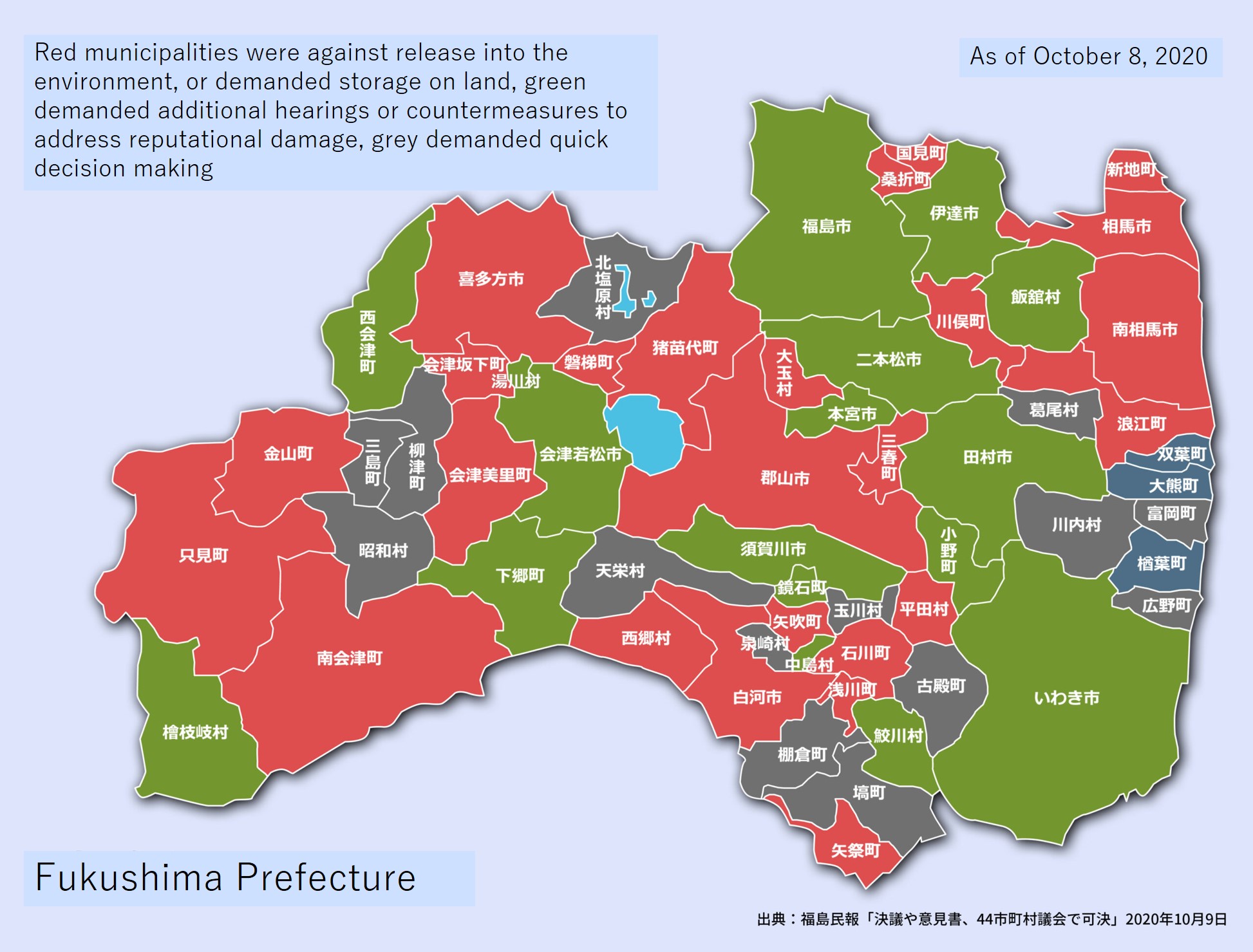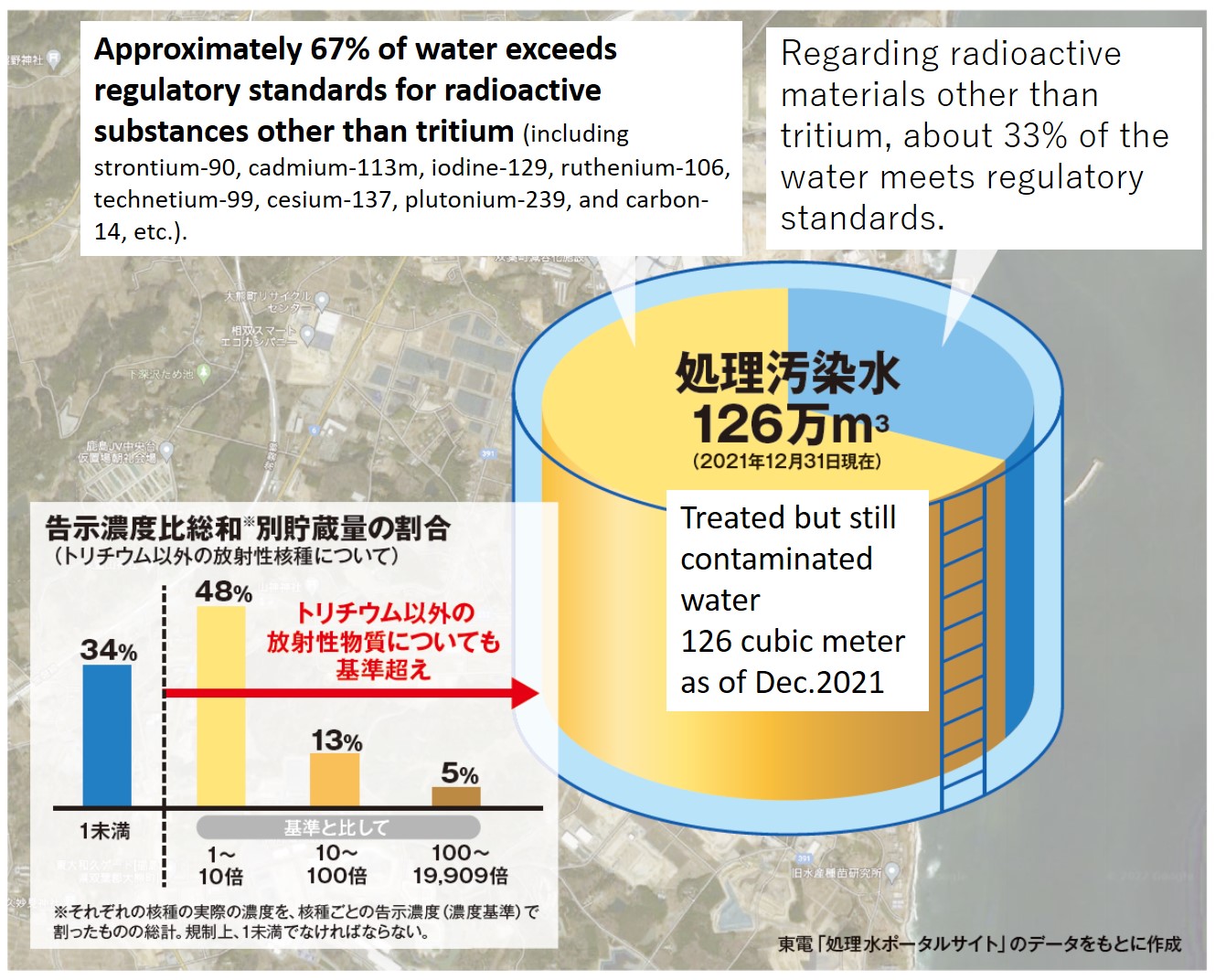[Q&A] ALPS-treated (but still contaminated) water at the Fukushima nuclear plant: 14 points to know
2023.8.1
The Japanese government and TEPCO are preparing to start releasing “ALPS-treated water” from the damaged Fukushima Daiichi Nuclear Power Plant into the ocean as early as late August 2023. Here are 14 key points to keep in mind, not often covered in the media.
Q: Is it “Treated water"? Or “contaminated water"?
Q: What is in the water?
Q: Is TEPCO measuring radioactive materials in all of the tanks?
Q: What is tritium?
Q: Is tritium safe?
Q: Tritium is released from nuclear power plants all over the world. So why is only this case being seen as a problem?
Q: What about claims of diluting tritium concentrations to “1/40th" of the regulated standard?
Q: Is ocean release the only option?
Q: Have they considered the “large tank storage” and “mortar solidification” proposals?
Q: Is there really a lack of space for storage on land?
Q: What would it mean to obtain “the understanding of the relevant parties"? Is that even possible?
Q: What is the opinion of local governments in Fukushima Prefecture? What about neighboring prefectures?
Q: Were public hearings held?
Q: What measures can be taken to prevent the volume of contaminated water from increasing further?
Q: What about the International Atomic Energy Agency (IAEA) “assurance" of the safety of the ocean release?
Q: Is it “Treated water"? Or “contaminated water"?
At the Fukushima Daiichi Nuclear Power Plant site, contaminated water is generated by the mixing of cooling water from nuclear fuel debris with groundwater and rainwater that flowed into the reactor and turbine buildings. It is treated with a multi-nuclide removal system (referred to as Advanced Liquid Processing System, or ALPS) and stored in tanks (Fig. 1). The total amount of water stored is 1.34 million cubic meters (as of July 2023).

The Japanese government and Tokyo Electric Power Company (TEPCO) refer to it as “ALPS treated water," but some people call it “contaminated water" because tritium and other radioactive substances still remain in the water, even after treatment.
More precisely, it should be called “water that has been treated but still contains radioactive substances." To make the point, we abbreviate this here as “ALPS-treated but still contaminated water" or “treated contaminated water." The Japanese government definition of “ALPS-treated water" is “water that satisfies standards regulating the release of nuclides other than tritium into the environment" (Note 1). However, about 70% of the water currently stored in tanks contains radioactive substances other than tritium at concentrations exceeding regulatory standards. Therefore, the term “treated water" doesn’t tell the whole story and is somewhat misleading. See the next point for details.

Q: What is in the water?
TEPCO announced that the treated contaminated water contains about 780 trillion becquerels of tritium (as of May 2021). In 2010, 2.2 trillion becquerels of tritium were released into the sea from the Fukushima Daiichi Nuclear Power Plant (Note 2, p15), so we are talking about an amount about 350 times greater than what the plant released in an entire year, prior to the accident.
It should be noted that the treated contaminated water also contains radioactive materials other than tritium, at concentrations exceeding regulatory standards. These include iodine-129, strontium-90, ruthenium-106, technetium-99, cesium-137, plutonium-239, carbon-14, cadmium-113m, and more.
At first, TEPCO explained that it was able to remove radioactive substances other than tritium by processing it through ALPS, and that the concentrations met regulatory standards.
At the public hearing held in August 2018, only data that met standards were shown (Fig. 2).

Fig. 2. “The characteristics of the ALPS treated water," data from materials distributed at public hearing in August 2018.
Regarding radioactive materials other than tritium (from left, cesium-137, strontium-90, iodine-129, ruthenium-106, cobalt-60, antimony-125, others, total excluding tritium, and tritium), the graph shows data from times when concentrations met regulatory standards after ALPS treatment.
However, according to Kyodo News and other media reports, radioactive substances other than tritium also remain in the water at levels above regulatory standards. (Note 3)
Later, TEPCO made an announcement revealing that nearly 70% of the water stored in tanks had concentrations of 62 radionuclides (other than tritium) exceeding standards for release, with the highest levels reaching around 20,000 times the limits. (Note 4) (Fig. 3)
TEPCO has stated that in order to meet regulatory standards for these radionuclides as well, it will conduct secondary treatment before discharging the water into the ocean.
The problem is with the amounts of these radioactive materials remaining in the tanks. Total amounts are not indicated. Also, the amounts of radioactive materials that will remain even after secondary treatment are not clear. Since the total amount of water is huge, even if concentrations are lowered, the absolute amount of radioactive material released will be large. Basic information about what will be released and in what amounts has not been provided.

Q: Is TEPCO measuring radioactive materials in all of the tanks?
TEPCO says that it conducted a “radiation impact assessment," and based on that, the government concluded that the impact on people and the environment of releasing treated contaminated water is so negligible that it can be ignored. But only three tank groups (36,000 cubic meters in total) are indicated by TEPCO as source terms (types and amounts of radioactive materials released). That accounts for just under 3% of the total amount of water in all the tanks. The reason to include only three tank groups was that they were the only ones for which TEPCO had complete data on 64 radioactive materials (the 62 nuclides processed by ALPS, plus tritium, and carbon-14) (Note 5).
TEPCO says it will sequentially measure for 30 nuclides before releasing water from the other tanks. It is estimated that it will take more than 30 years for the release to be completed, so what kinds of radioactive materials end up being released and in what quantities will not be known until the release has been completed (in about 2063). Regarding seven major nuclides, plus tritium and carbon-14, the measurement data for all tank groups has been released, but due to the large variation between tanks, no one could claim that the three tank groups mentioned above are representative of all tanks.

Q: What is tritium?
Tritium is also known as tritiated hydrogen and is an isotope of hydrogen. It is made up of one proton and two neutrons. Tritium is a radioactive element with a half-life of 12.32 years that decays into helium by beta decay. It only releases 18.6keV of energy, which is about 1/30th of 512 keV, the maximum amount of energy that can be released by Cesium-137.
Tritium exists naturally as tritiated water but there has been an increase in tritium released into the environment from nuclear testing and nuclear power plants.
Q: Is tritium safe?
Expert opinions on the effects of tritium are divided. The government tries to emphasize that it is safe, saying that even a sheet of paper can block radiation from tritium, it has the same properties as water, its bioconcentration in humans and living organisms has not been confirmed, and so on. Beta rays emitted by tritium travel a shorter distance than gamma rays, but the problem with these radioactive substances is the effect they have when they enter the body.
Tritium can replace the hydrogen atoms in organic compounds. Some experts point out that tritium bioaccumulation occurs as it progresses through the food chain, and when tritium replaces hydrogen atoms within the human body, it affects surrounding cells. It is also pointed out that when tritium replaces hydrogen atoms in DNA, the tritium decays into helium and damages DNA. (Note 6)

Q: Tritium is released from nuclear power plants all over the world. So why is only this case being seen as a problem?
The major difference between the treated contaminated water to be released from Fukushima Daiichi and wastewater discharged from typical nuclear power plants is that, even though it has supposedly been treated, water from Fukushima Daiichi has been in contact with debris (melted nuclear fuel). That means the water contains various radioactive materials other than tritium.
As for tritium, certainly, it is released from nuclear power plants in Japan and other countries. Tritium is released on a scale of hundreds to trillions of becquerels per year from boiling water reactors (BWR) in Japan, and tens of trillions of becquerels per year from pressurized water reactors (PWR). A bigger amount of tritium will be released from the Rokkasho spent nuclear fuel reprocessing plant in Japan (construction not yet completed). However, the cumulative impacts of a gradually increasing amount of tritium in the environment is still unclear.Simply stating that tritium is being released by nuclear power plants around the world is no excuse or justification to release more.

Q: What about claims of diluting tritium concentrations to “1/40th" of the regulated standard?
The government and TEPCO say the treated contaminated water will be diluted with seawater and released with a tritium concentration of 1,500 becquerels per liter. This is explained as being just “1/40th" of the regulated standard of 60,000 becquerels per liter, but is that really the case?
Note that 60,000 becquerels/liter is the standard for when there are no radiation sources to be considered other than wastewater on the site of the nuclear power plant, and when the wastewater contains only tritium.
Legislation calls for an additional radiation dose limit of 1 millisievert per year at the site boundary of the Fukushima Daiichi Nuclear Power Plant, but considering the various radiation sources on the site, the liquid waste dose should be limited to about 0.2 millisieverts. Also, as the water contains other radioactive substances such as cesium-134, cesium-137 and strontium-90, the limit for concentration of tritium was set at 1,500 becquerels/liter. (Note 7)

Q: Is ocean release the only option?
The Citizens Commission on Nuclear Energy (chaired by professor Kenichi Oshima of Ryukoku University), which includes engineers and researchers, has proposed “large tank storage" and “mortar solidification disposal" instead of releasing wastewater into the ocean or atmosphere (Note 8). See the next item for details.

Q: Have they considered the “large tank storage” and “mortar solidification” proposals?

The large tank storage proposal is based on proven methods from the petroleum industry to use large tanks with dome-shaped roofs and water-sealing vents, each with a capacity of 100,000 cubic meters. They could be installed on sites originally intended for future Units 7 and 8 of the Fukushima Daiichi Nuclear Power Plant, as well as soil dumping sites, or adjacent land at the nuclear plant.
TEPCO has dismissed the idea of storage in large tanks, citing the potential for rainwater contamination and large amounts of leakage in the event of damage. The government adopted the same stance, and gave the idea no further consideration. However, large tanks are a proven method for oil storage, and obviously, the petroleum industry successfully takes steps to prevent rainwater contamination and leakage in the event of damage to the tanks.

Source: Savannah River Remediation LLC (SRR)
The “mortar solidification disposal" method has already been used in the disposal of contaminated water at the Savannah River nuclear facility in the United States. Contaminated water was mixed with cement and sand to create mortar, stored in a partially buried state.
Mortar solidification has merits as a stable method of storage that avoids the risk of radioactive materials being released into the ocean. Due to these advantages, the Citizens Commission on Nuclear Energy recommends mortar solidification over large tank storage. TEPCO and the government claim there are problems with hydration heat and water evaporation, but the Citizens Commission responds that there are methods to deal with such concerns. At any rate, these alternatives have not been properly discussed publicly in any way that allows the proponents to participate.

Q: Is there really a lack of space for storage on land?
TEPCO’s current site utilization plan is based on an intention to remove debris (melted nuclear fuel) from the damaged reactors. A large amount of space has been reserved for the temporary storage of retrieved debris. However, the debris removal process has run into serious problems, and even if debris can be removed, there is no clear plan for how to deal with it. Some people have pointed out that the current decommissioning roadmap has already failed. It is time to revisit and revise these plans.

Q: What would it mean to obtain “the understanding of the relevant parties"? Is that even possible?
In 2015, the government and TEPCO promised in writing to the Fukushima Prefectural Federation of Fisheries Cooperatives (Fukushima-ken Gyoren) that they would take no action regarding treated contaminated water “without the understanding of the relevant parties."
Despite that, in April 2021, the government made the decision to release treated contaminated water into the ocean.
Since then, both the Fukushima Prefectural and National Fisheries Federations of Fisheries Cooperatives have repeatedly expressed their opposition to the ocean release. For four consecutive years they have adopted special resolutions against the release. (Note 9) In addition, in July 2023, the Soma Futaba Fisheries Cooperative conveyed its “firm opposition" to the government (Note 10). The scope of what is meant by “the relevant parties" is ambiguous, admittedly. But fishermen are arguably among the most relevant parties, and their “understanding” has certainly not been obtained.

Q: What is the opinion of local governments in Fukushima Prefecture?
As of October 2020, 44 out of 59 municipalities in Fukushima Prefecture had passed written statements and resolutions regarding the release of treated contaminated water. Of these, 27 were against the release, or called for storage on land, and 14 requested careful hearing of opinions from the relevant parties and measures to prevent reputational damage. (Fig. 4, Note 11)

Since April 4, 2021, when the government adopted the policy to release the treated contaminated water into the ocean, 23 municipal assemblies have adopted written statements on the topic. Of these, 16 demanded that the policy be withdrawn or opposed, and that treated water be stored on land. Six demanded measures to prevent reputational damage and a proper explanation of ocean release. Iwaki City called on the government and TEPCO to fulfill commitments made to fisheries associations. (Note 12)
In a neighboring prefecture, the Miyagi Prefectural Assembly unanimously adopted a statement opposing ocean release in July 2023. (Note 13)

Q: Were public hearings held?
In August 2018, the government held one “explanatory public hearing” at two locations in Fukushima and one location in Tokyo. Of the 44 speakers, 42 explicitly opposed any ocean release. No public hearings have been held since then. (Note 14)

Q: What measures can be taken to prevent the volume of contaminated water from increasing further?
Contaminated water will continue to be generated unless the inflow of groundwater into the structures is stopped. To date, countermeasures such as frozen soil walls, groundwater bypasses, and water pumping from wells (subdrains) near the structures have been taken, and although they have had a certain degree of effect, the inflow of groundwater continues. A research group led by professor Naoaki Shibasaki of Fukushima University has proposed that a “wide-area impermeable wall" be constructed outside the current frozen soil wall to stop the inflow of groundwater. This is a conventional construction method that uses concrete, clay, etc. The cost is about half that of a frozen-soil wall, and the construction period is several years. (Fig. 5, Note 15) Furthermore, it has been proposed that the groundwater level can be effectively lowered by installing a “collection well and drainage bore" in the area surrounded by the “wide-area impermeable wall."
However, the proposal still has not been seriously considered.

Source: CHI booklet series 16 “Why does contaminated water continue to accumulate at Fukushima Daiichi Nuclear Power Plant?" p. 26

Q: What about the International Atomic Energy Agency (IAEA) “assurance" of the safety of the ocean release?
In July 2023, the IAEA issued a comprehensive report to the effect that the release of treated contaminated water into the ocean is in line with international standards. As a result, media have been reporting that the release into the ocean has received the IAEA’s “endorsement."
However, the IAEA’s review is essentially based on information provided by the Japanese government and TEPCO, and alternatives other than ocean release were not included in the review. In addition, as mentioned above, the source term presented by TEPCO as the basis of the radiation impact assessment only covers three tank groups (holding only 3% of all the water in tanks).
It is noted that the IAEA is an agency that promotes the use of nuclear energy, so it cannot be described as a neutral party. In light of IAEA safety standards, releasing the treated contaminated water into the ocean is not consistent with at least regarding to “justification of radioactive discharge to the environment" and “involvement of interested parties". Its conclusion is simply a repeat of the views of the Japanese government. For details, see the Citizens Commission on Nuclear Energy’s “Commentary: The IAEA Comprehensive Report does not provide a “scientific basis” for the oceanic release of ALPS-treated radioactive wastewater."(Note 16)

NOTES (In Japanese unless indicated otherwise)
Note 1. Ministry of Economy, Trade and Industry “Changed definition of ALPS-treated water at TEPCO Fukushima Daiichi Nuclear Power Station" (April 13, 2021).
Note 3. Kyodo News, “Detection of Radioactive Substances Exceeding Standard Values/Other Than Tritium, Long Lifespan," August 19, 2018.
Note 4. Ministry of Economy, Trade and Industry “Subcommittee on the handling of treated water by multi-nuclide removal equipment (10th meeting)," document 3.
Note 5. Response from TEPCO to FoE Japan question (February 8, 2022).
Note 6. For example, see below.
Toshiyuki Bada, “Evaluation of biological effects of tritium" (Journal of University of Occupational and Environmental Health, Vol.31 No.1 (2017) p. 25).
Ian Fairlie, Hypothesis to explain childhood cancers near nuclear power plants, Journal of Environmental Radioactivity, Volume 133, July 2014, pages 10-17 (in English).
Chihiro Uesawa, “Tritiated Water from the Fukushima Daiichi Nuclear Power Plant" (Science, May 2013).
Tim Deere-Jones (Marine Radioactivity Research & Consultancy: Wales: UK), “Tritiated water and the proposed discharges of tritiated water stored at the Fukushima accident site” (in English).
Note 7. Tokyo Electric Power ”About the operation target of the groundwater bypass (drainage standard)" (December 16, 2016).
Note 8. Citizens Commission on Nuclear Energy “Views on ALPS Treated Water Handling.”
Note 9. NHK News Web, “The Prefectural Fisheries Federation adopts a special resolution for the fourth consecutive year to oppose the discharge of treated water" (June 23, 2023).
Asahi Shimbun “Zengyoren resolves to “oppose” the release of treated water from nuclear power plants into the ocean TEPCO plans to release it in the summer" (June 22, 2023).
Note 10. Asahi Shimbun “Souma Futaba Fisheries Cooperative 'Resolute Opposition’ Approaching Release of Treated Water," July 19, 2023.
Note 11. Fukushima Minpo “Resolutions and Opinions Approved by 44 Municipal Assemblies,” October 9, 2020.
Note 12. Asahi Shimbun, “40% of local assemblies [adopted] opinions," July 6, 2023.
Note 13. NHK Online, “Opposition to ocean discharge of treated water Miyagi Prefectural Assembly unanimously approved," July 4, 2023 (accessed July 31, 2023).
Note 14. Many meetings were held for those who the government designates as “relevant parties,” but public meetings where anyone can participate and express their opinions were not held under the auspices of the government.
Note 15. CID booklet series 16, “Why does contaminated water at the Fukushima Daiichi Nuclear Power Plant continue to increase?" p. 26. Note 16. Citizens Commission on Nuclear Energy, “Opinion: The IAEA Comprehensive Report does not provide a 'scientific basis’ for the release of ALPS-treated contaminated water into the sea, July 18, 2018.
